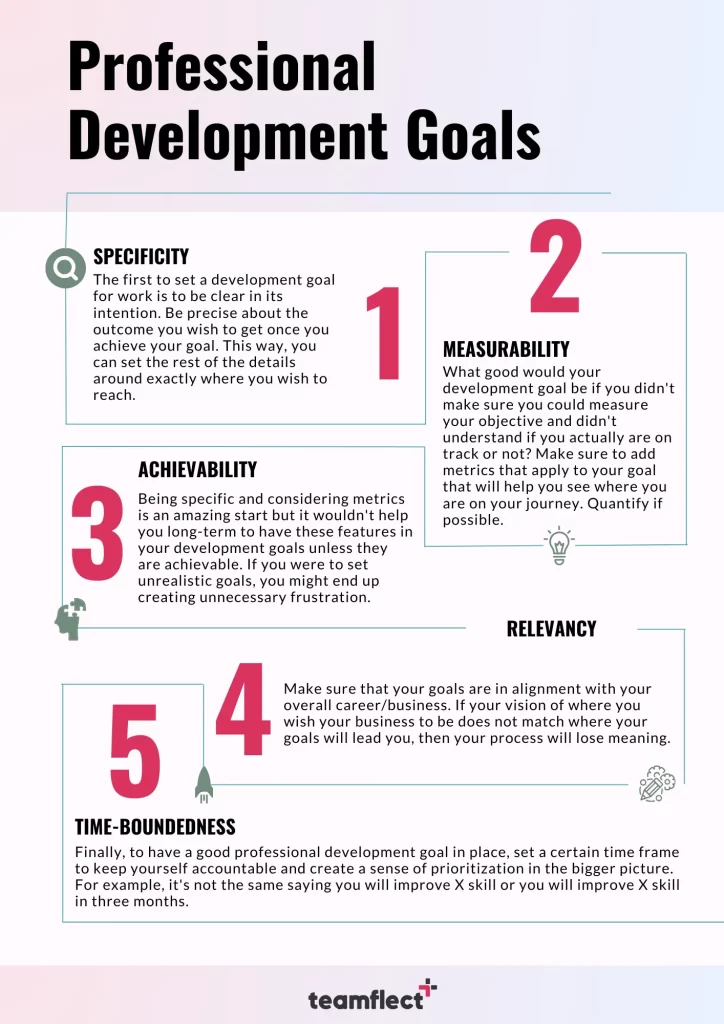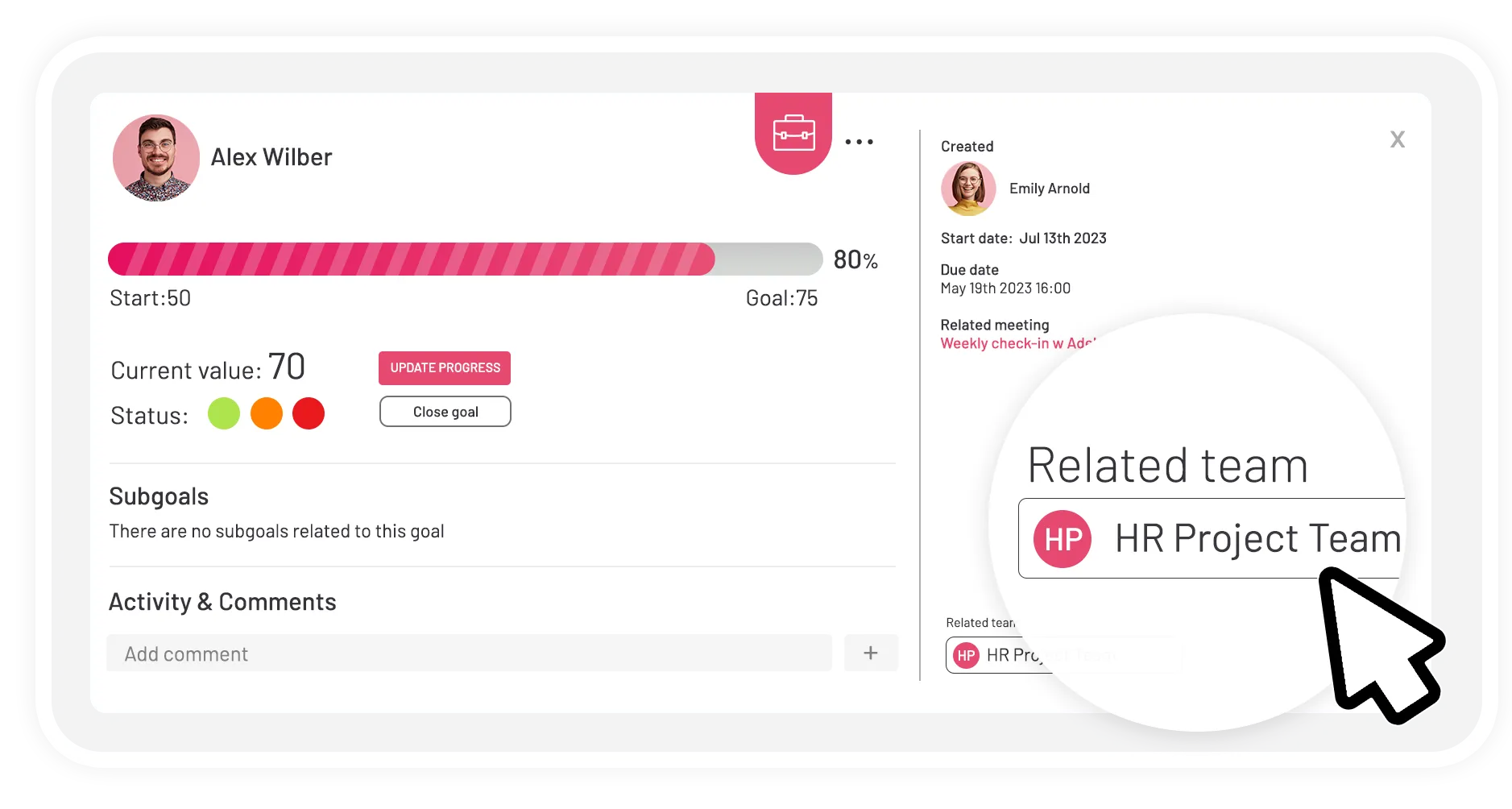These days, staying ahead of the curve is not just a goal but a necessity. As we work our way through ever-evolving industries and a very fast-paced business world overall, being able to grow and stay agile in the workplace continuously is more important than ever before.
This is where professional development goals come in.
With this perspective in mind, having a roadmap in order to have a clear vision of where your business is going is essential. Therefore, setting yourself professional development goals is at the center of a successful organization.
Whether you’re only starting out or have already advanced in your current place in your career, professional development is always on our minds. But how exactly do we go about setting and implementing them?
Let’s discover the importance and cornerstones of what professional development goals are and get you equipped to set your own!
Table of Contents
What Should A Professional Development Goal Include?
By now we’ve all heard of SMART Goals, and for good reason! A professional goal that’s going to actually help you and your organization grow and develop in business should be in alignment with SMART Goals. But what does it stand for?
SMART: Specific, Measurable, Achievable, Relevant, and Time-bound. So, by this logic let’s list the components your development goals should include.

- Specificity: The first to set a development goal for work is to be clear in its intention. Be precise about the outcome you wish to get once you achieve your goal. This way, you can set the rest of the details around exactly where you wish to reach.
- Measurability: What good would your development goal be if you didn’t make sure you could measure your objective and didn’t understand if you actually are on track or not? Make sure to add performance metrics and performance review competencies that apply to your goal that will help you see where you are on your journey. Quantify if possible.
- Achievability: Being specific and considering metrics is an amazing start but it wouldn’t help you long-term to have these features in your development goals unless they are achievable. If you were to set unrealistic goals, you might end up creating unnecessary frustration. Doing so will also improve your employee engagement.
- Relevancy: Make sure that your goals are in alignment with your overall career/business. If your vision of where you wish your business to be does not match where your goals will lead you, then your process will lose meaning. In the same way, your career development plans go so well with performance appraisal, your goals should match your industry.
- Time-boundedness: Finally, to have a good professional development goal in place, set a certain time frame to keep yourself accountable and create a sense of prioritization in the bigger picture. For example, it’s not the same saying you will improve X skill or you will improve X skill in three months. This is especially important if you wish to create an effective and clear development plan that will help you and your goals.
- Bonus – Long-Term vs Short-Term Goals: Breaking down your goals into long-term and short-term tasks can help you achieve your objectives faster and integrate the process into your day-to-day rather than cramming your goal into a shorter time to meet your own deadlines. This way you will have an actual professional development plan.
Professional Development Goal Examples
1. Improve Time Management
Short Term: Reduce time spent on non-essential tasks by tracking this time via time management tools and techniques, resulting in a decrease in time spent on non-essential tasks by 20% within the next three months.
Long Term: Establish a detailed time management strategy by implementing advanced tools and techniques in order to track and optimize time spent on non-essential tasks. Aim for a sustained and gradual reduction in time spent on non-essential tasks, targeting an overall 30% decrease within the next year.
2. Enhance Communication Skills
Short Term: Enhance written and verbal communication skills by actively participating in workshops every three weeks minimum, consistent practice, and seeking feedback from mentors. Strive for a 5% improvement in communication proficiency within the next two months.
Long Term: Improve both written and verbal communication by attending workshops, practicing regularly, and seeking feedback from mentors because effective communication is crucial in professional settings. Achieve a 15% improvement within the next six months.
3. Develop Leadership Abilities
Short Term: Take leadership roles in projects and successfully lead at least two projects within the next year, supporting the experience by attending leadership programs and completing the training within the same time frame simultaneously.
Long Term: Consistently pursue leadership roles in various projects, aiming to lead at least two projects per year over the next 2-3 years. Simultaneously, invest in continuous professional development by participating in leadership programs, completing advanced training, and seeking mentorship opportunities.
4. Expand Professional Network
Short Term: Attend industry-related events and regularly engage in online discussions to increase networking opportunities and take part in at least one networking event per month for the next six months.
Long Term: Be consistent in engaging in industry-related events, both physical and virtual, while actively contributing to online discussions and forums. Aim to participate in at least one networking event per month for the next 1-2 years to establish a robust professional network.
5. Acquire New Technical Skills
Short Term: Learn a specific programming language by completing a relevant online certification course and dedicate at least 5 hours a week in order to complete the course within six months.
Long Term: Dedicating at least 5 hours a week to advanced learning and aim to not only complete the initial certification course within the first six months but also deepen your understanding and expertise over the next 1-2 years through real-world applications and staying updated with the latest advancements in the programming language.
6. Improve Product Management Skills
Short Term: To enhance project planning and execution skills, take courses and apply the learnings in at least two project initiations. Complete two successful projects within the next nine months.
Long Term: Commit to continuous improvement and apply the learnings in various project scenarios, ensuring a holistic understanding, Strive to complete and successfully lead a series of progressively complex projects over the next 1-2 years, showcasing the evolution of skills and expertise in project planning and execution.



